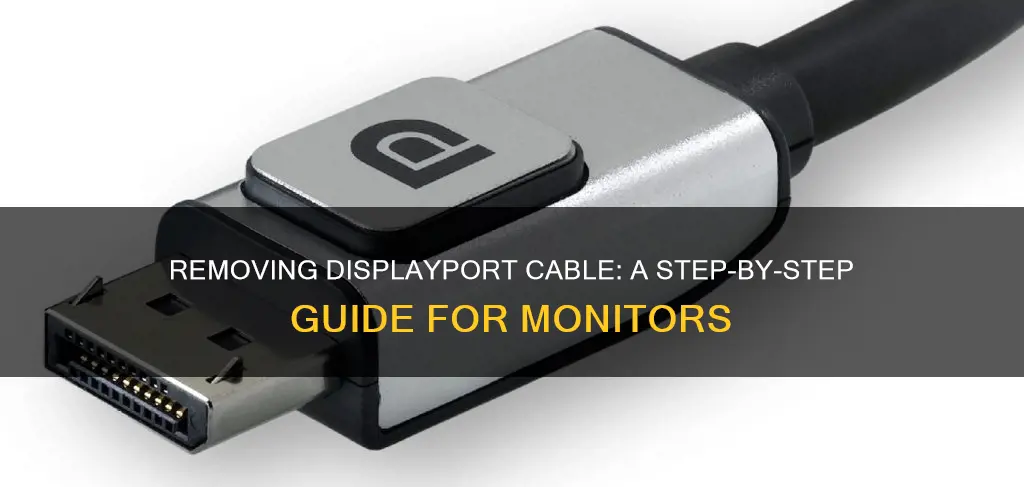
DisplayPort cables are designed with a locking connector to prevent the connection from coming loose. This is why simply pulling out the cable is likely to cause damage. To safely remove the cable, you need to press a button on the connector to release the lock, then gently pull out the cable.
| Characteristics | Values |
|---|---|
| Difficulty | Unplugging a DisplayPort cable is not difficult |
| Locking Mechanism | DisplayPort cables use a locking connector |
| Release Button | Pressing the button will release the lock, allowing easy removal of the cable |
| Brute Force | Do not attempt to remove the cable using brute force |
| Cost | Damaging components can be costly to rectify |
| Loose Connections | A loose connection can cause issues such as flickering |
| Setup | Keep cables out of the way to minimise the risk of entanglement |
| Cable Type | Some DisplayPort cables don't have a locking mechanism and can be detached without pushing a release button |
| Broken Release Button | If the release button is broken, try pushing harder than usual to release it |
What You'll Learn

Locate the release button on the DisplayPort connector
To remove a DisplayPort cable from your monitor, you must first locate the release button on the DisplayPort connector. This button is typically found on the connector itself, so take a close look at the connector end of the cable. The button may be on the top or bottom of the connector, depending on how it is oriented in the device. Some DisplayPort cables may not have a locking mechanism and can be detached without pushing a release button, but most do.
The release button is usually quite small, so you may need to feel around for it carefully. Once you've located the button, press it down gently but firmly. You may need to apply a bit more pressure than you expect to release the lock. If the button is stiff, don't force it too hard, as you don't want to break the button. Instead, try pressing it down harder while simultaneously pulling the cable out.
If the release button is broken, you may still be able to remove the cable without causing further damage. Try pressing the button as hard as you can while gently pulling on the cable to release the lock. If that doesn't work, some people have reported success using needle-nose pliers to activate the release mechanism. It's a delicate operation, but it's worth trying if your cable is already broken.
Another option for a broken release button is to remove the shroud from the graphics card and push the pins from the inside. This method is more invasive, so proceed with caution. Alternatively, you can try using a precision tool, such as a retrieval hook, to press the button while pulling the cable out. This method can also put stress on the plug, so be cautious.
Joystick Navigation: 5-Way Control on ASUS Monitors
You may want to see also

Press the button to release the lock
To remove a DisplayPort cable from your monitor, you'll need to press the button on the connector to release the lock. This is because DisplayPort cables use a locking connector to ensure a secure connection and prevent it from coming loose. Simply pulling the cable out without pressing the button first can cause damage to your components, so it's important to follow the correct steps.
The button on the connector will be small and may be located on the top or bottom, depending on the orientation of the device. Once you've located the button, press it down gently. You may need to use a bit of force, but be careful not to press too hard as the button can be fragile.
After pressing the button, gently pull on the cable to remove it from the port. It should come out easily without needing to use excessive force. If you find that the cable is still stuck, try pressing the button again to ensure that the lock has been fully released.
In some cases, the release button may be stiff or broken. If the button is stiff, try pushing harder than you normally would to release it. If the button is definitely broken, you may need to use needle-nose pliers to activate the release mechanism. Alternatively, you can try pushing or pinching the connector in different directions, as some DisplayPort cables have a specific mechanism that requires you to push or pull in a certain way to release the lock.
It's important to note that not all DisplayPort cables have a locking mechanism. Some cheaper cables may not have the button, so you can simply pull them out without pressing anything. Always check your cable carefully before attempting to remove it.
LCD Monitor Imports: Classifying for Success
You may want to see also

Gently pull the cable out
To gently pull the DisplayPort cable out of the monitor, start by locating the button on the connector. This button is typically found on the top or bottom of the connector, depending on how it is oriented on the device. Once you've found the button, press it down gently but firmly. You may need to apply a bit of force, but it's important not to press it too hard as you could risk damaging the components.
After pressing the button, gently pull or yank the cable out. It should come out easily without requiring too much force. If you find that the cable is still stuck, try pressing the button again and giving it another gentle pull. Be careful not to use brute force as this could damage the cable or the monitor.
In some cases, the release button on the connector may be broken or particularly stiff. If the button is broken, you may need to use needle-nose pliers to activate the release mechanism. Alternatively, if the button is simply stiff, try pushing harder than you usually would to release it.
It's worth noting that some DisplayPort cables, particularly cheaper ones, may not have a locking mechanism at all. In this case, you can simply pull the cable out without needing to press a release button first. However, always check carefully to see if your cable has a locking mechanism before attempting to remove it.
Is Your Monitor 3D? Check for These Clues
You may want to see also

If the release button is broken, push harder or use needle-nose pliers
If the release button on your DisplayPort cable is broken, there are a few things you can try to remove it safely without damaging your components. Firstly, it's important to assess whether the button is stiff or definitely broken. If it's just stiff, you can try pushing harder on the button to release the lock and gently remove the cable.
However, if the button is broken, you can try using some needle-nose pliers to activate the release mechanism. Before doing so, make sure to power off and unplug the device you are trying to disconnect. This is an important safety precaution when working with electricity. Once you've ensured the device is off and unplugged, use the needle-nose pliers to push down on the metal hooks connected to the tabs, releasing them from the appliance. While continuing to push down on the hooks, pull the cord out of the back of the monitor.
If you don't have needle-nose pliers, you can try using a binder clip. First, unplug and power off the monitor. Then, clip the binder clip to the head of the cable, nearest the monitor. If necessary, cut the cord off the head to make removal easier. Apply a little more pressure to the binder clip to press down the latches, and then pull the cord out while continuing to apply pressure.
If your DisplayPort cable is broken and jammed in the monitor port, you can also try using tweezers to remove the remaining parts of the cable from the port.
Monitoring Data Usage: Track Device Consumption
You may want to see also

Avoid using brute force to remove the cable
DisplayPort cables are designed with a locking connector to ensure the connection doesn't come loose. This means that simply pulling out the cable is likely to cause damage.
To avoid using brute force to remove the cable, follow these steps:
- Locate the button on the connector. This is usually on the top or bottom of the plug, depending on the orientation of the device.
- Press the button to release the lock.
- Gently pull the cable out.
If the release button is broken or stiff, try pressing harder to release it. If it's definitely broken, you may be able to release the cable using needle-nose pliers to activate the release mechanism.
DisplayPort cables are designed to be easy to insert and difficult to remove, so make sure you push the plug in all the way, press the button, and then pull the plug out.
By following these steps, you can safely remove your DisplayPort cable without risking damage to your components.
Asus Monitors: G-Sync Compatibility and Performance
You may want to see also
Frequently asked questions
DisplayPort cables use a locking connector. Find the button on the connector, press it to release the lock, then gently remove the cable.
Try pushing harder than you normally would to release the button. If it's definitely broken, you may be able to release the cable and then use needle-nose pliers to activate the release mechanism.
Some DisplayPort cables, usually cheaper ones, don't have a locking mechanism. In this case, you can just unplug the cable without needing to push down on a release button.







